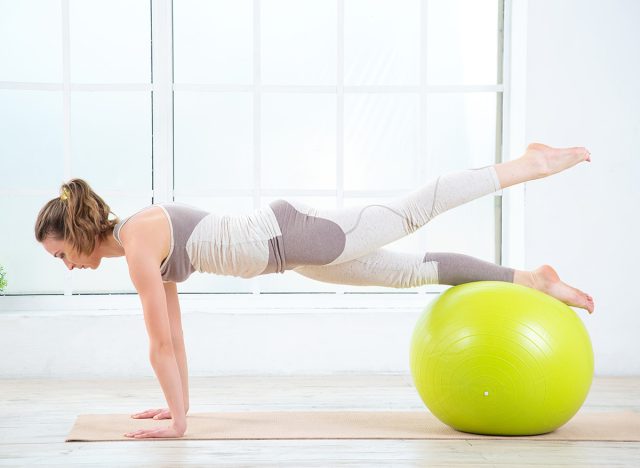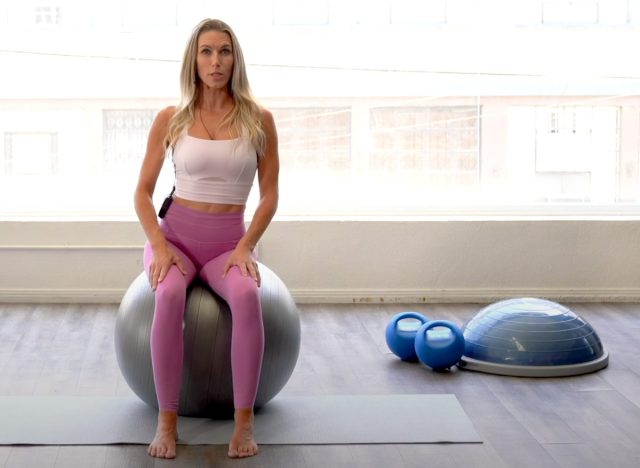#1 Way to Flatten Your Stomach for Women, According to a Pelvic Floor Expert

I have been in the fitness industry for over 20 years, and one of the things female clients ask me the most is, how can I flatten my stomach? I have some personal experience trying to flatten my own. After the birth of my children, I suffered from pelvic floor dysfunction, including bladder incontinence, lower back pain, and diastasis recti (separated abs), which led me to develop my passion and specialty in pelvic floor health. I knew I wasn't stuck to a lifetime of bladder leakage and wanted to create programs that would be accessible to all women so anyone needing help with issues could get it—and also get a strong, lean mid-section. Here's how you can get yours.
The Foundation of a Woman's Core

The pelvic floor is the foundation of a woman's core. The pelvic floor aids in our bladder, bowel, and sexual function. At least ⅓ of all women will experience pelvic floor dysfunction at some point in their lives, and this leaves the spine and abdominals not functioning optimally. Many women have diastasis recti after pregnancy, and even women who haven't been pregnant can get it. This causes a separation in the abdominals and will often cause a belly pooch that sit-ups and planks, and many traditional exercises make it worse. Our transverse abdominals act like a corset to balance abdominal pressure and support the spine. If we have diastasis recti, shallow breathing, suck in our stomach a lot (causes gripping and overuse of the upper abs), or a myriad of other issues going on, we can get pelvic floor dysfunction and abs that aren't working right. The lower abdominals often pooch out; a flat stomach seems impossible, but it is from dysfunction in the core.
Related: Alex Rodriguez's Girlfriend, Jaclyn Cordeiro, Flaunts Abs in "Friday Flex" Mirror Selfie
Train Your Deep Abdominals

Doing pelvic floor exercises trains your deep abdominals to function well, and diaphragmatic breathing (aka belly breathing) helps with the elasticity of the pelvic floor and abdominal activation. Many recommend Kegels and Kegel exercises to tighten the pelvic floor. While they are appropriate for some women who are overstretched throughout the pelvic floor, for women with a hypertonic pelvic floor or who have parts of the pelvic floor with too much tension, they will make issues worse and even can create new issues. Kegels are concentric contractions and can lead to chronic tension and tightening of the pelvic floor, which can lead to painful intercourse, incontinence, lower back pain, and difficulty achieving orgasm, among other issues. Unless a woman is seeing an internal therapist to monitor tension throughout the pelvic floor, women are not going to know if their issue is too much tension, not enough, or a combination of so many women experience a poor outcome from Kegels. They are also one exercise that doesn't train the pelvic floor to be dynamic and train its fourteen muscles for optimal strength and elasticity throughout. There are far better ways to train the pelvic floor while at the same time building strength in the entire core, leading to strong and high-functioning abs.
Your Secret Weapon

I love using a stability ball with pelvic floor exercises because the ball activates your deep abdominals and improves stability far better than exercises on a mat or stable object. Pelvic floor exercises that emphasize full body and dynamic movement are optimal. Training your pelvic floor to be strong, toned, and responsive through all planes of motion trains your abdominals to be highly functioning and helps flatten your stomach even without any changes in diet or weight loss. This is because they will engage your transverse abdominals; if you have diastasis recti, they help close that gap for most. Using concentric and eccentric contractions trains the pelvic floor muscles for optimal strength and tension throughout while at the same time helping your posture and helping flatten your abs. They are the secret weapon I have used for over 20 years, and once women realize how effective they are at accomplishing so much, they are hooked.
Related: This Is the Exact Daily Routine That Helped Me Lose 50 Pounds, Says Fitness Expert
How My Body Changed and Yours Can, Too

I haven't done sit-ups, planks, leg lifts, and traditional abdominal exercises in over 20 years, yet my abs are strong and flat. My body completely changed once I started training differently and learned about biomechanics and corrective exercises, and I felt better than ever. My wish for all women is to learn that fitness and good movement/posture are attainable without hours in the gym. Creating balance and good biomechanics leads to improved confidence and carries into our daily life so we show up happier and healthier to live our best lives. So, for any of you ladies wanting a flat stomach, pelvic floor exercises are key.
💪🔥Body Booster: Here is a quick free pelvic floor workout (a Poosh favorite) to get you started and just a portion of the powerful programs within my app.
Courtney Virden is a Founder & Pelvic Floor Expert at iCORE Method.




